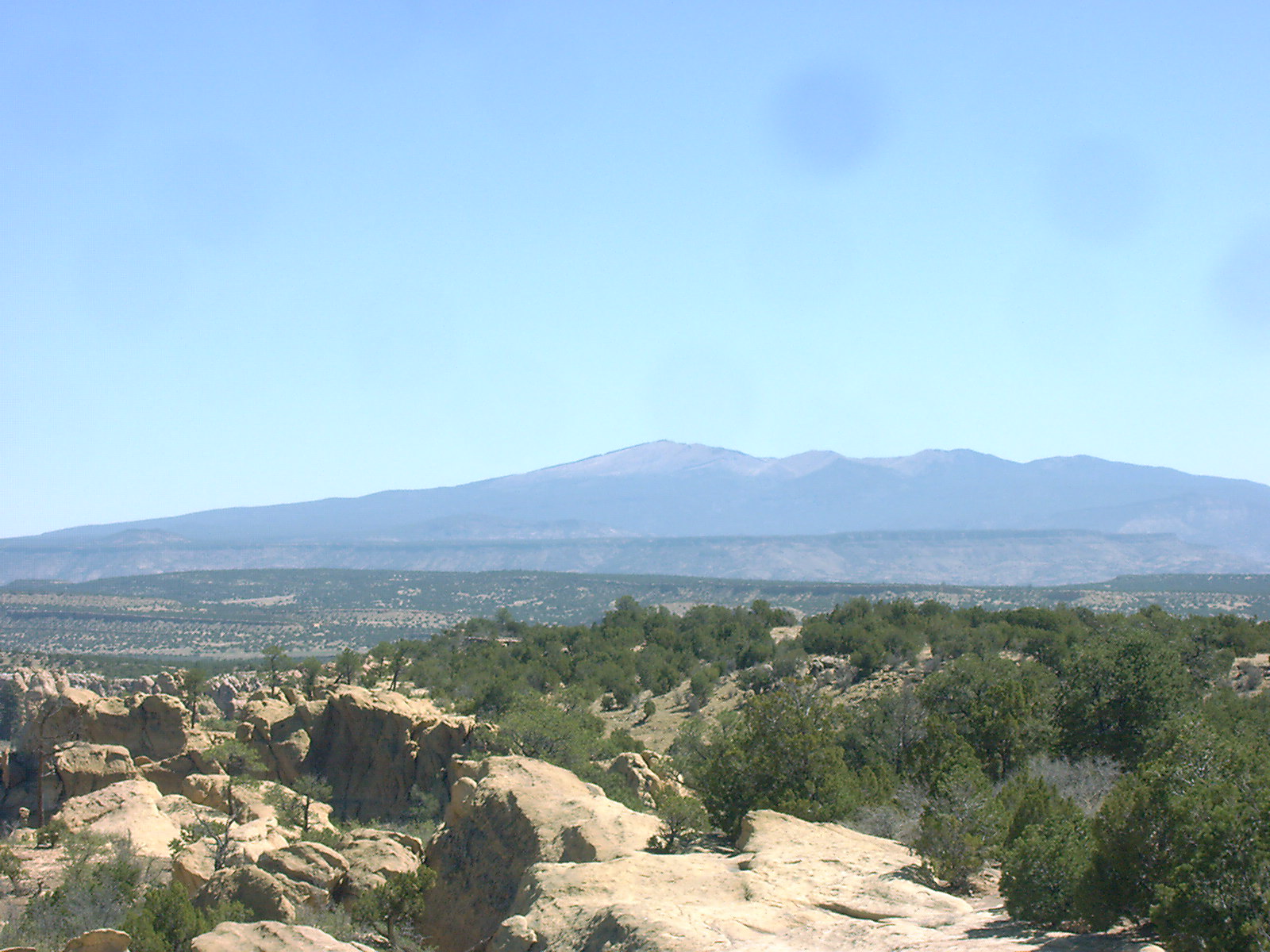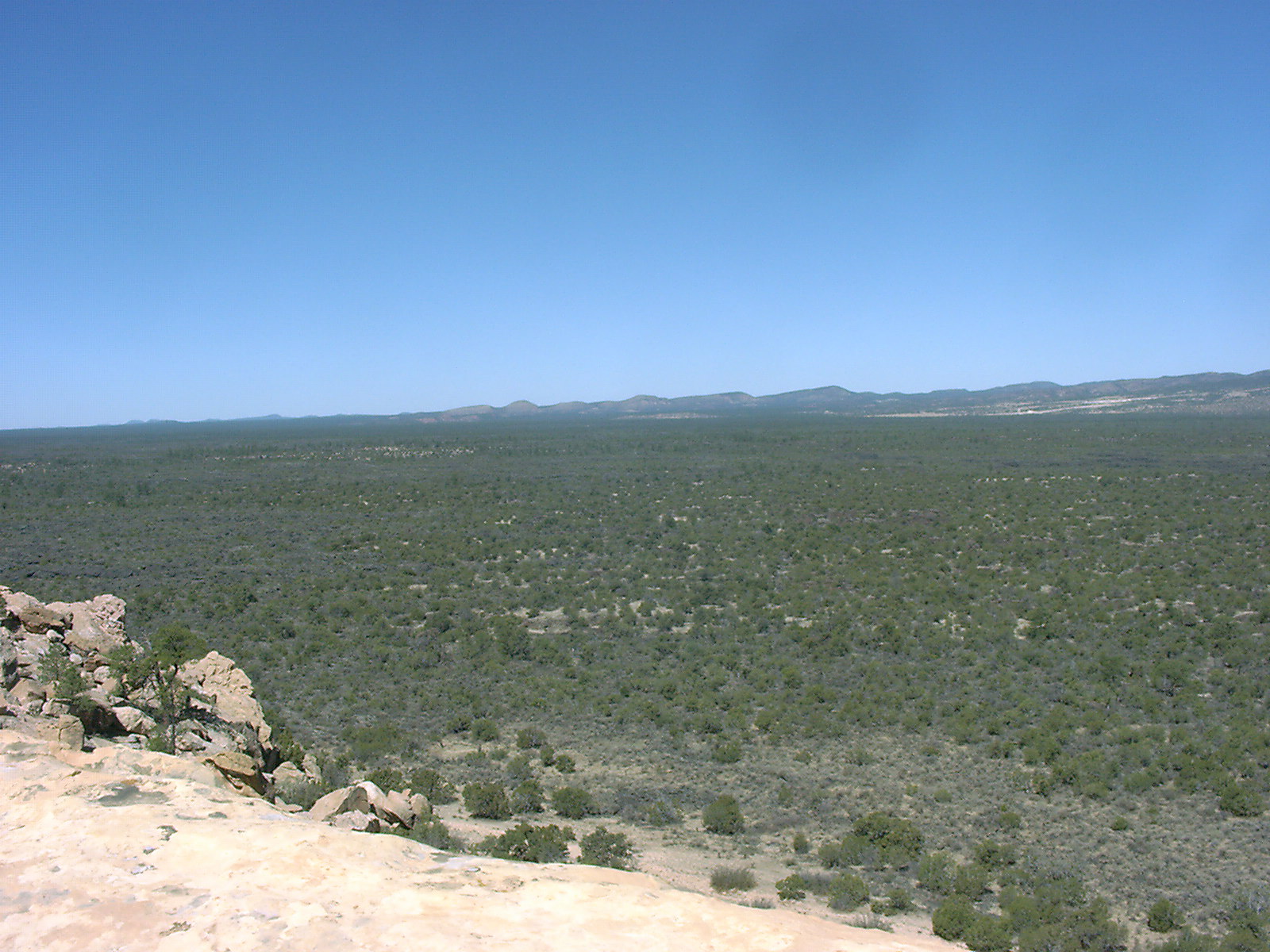Geography and Environment
All of the sites sampled in 2006 are within a day's drive of Grants, NM, in the northwestern corner of the state. The topography of this region varies considerably. Between Gallup and Grants lie the Zuni Mountains, where the students sampled peeled trees (publication forthcoming) in the Cibola National Forest. To the south of Grants, the topography flattens out into broad plains dotted with wide mesas. In this area, the most significant geographical features are the extinct volcano commonly known as Mount Taylor, and the associated lava fields called "El Malpais". In the Cebolla Wilderness of the BLM's El Malpais Conservation Area, the students sampled two forked-pole hogans and a historic homestead. Both the hogan local environment and the homestead local environment are best understood within the broader context of northwestern New Mexico and the more specific context of the Cebolla Creek watershed.
Northwestern New Mexico
Geology Climate Ecology
Major Topographic Features
Geology
To the north of El Malpais are limestone and sandstone ridges which date to the Permian Period (around 280 million years old).
To the east and south are Dakota Sandstone, Mancos Shale, and Crevasse Canyon Formations dating to the Jurassic Period (around 130 million years old).
Climate
Northwestern New Mexico receives an average 15 inches of rainfall annually. Most of the rainfall comes from severe thunderstorms during the summer monsoon season (July, August, and September). The rest of the precipitation generally occurs as snow during the winter.
The area experiences a wide range of temperatures, not only seasonally, but also daily. Winter temperatures in the daytime range from 30-50 degrees Fahrenheit, plunging below -20 at night. Summer temperatures have a daytime range from 80-100 degrees, and a nighttime range of 40-60 degrees.
Ecology
El Malpais is an ecological wonder. Because of the varied geology, diverse habitats are found in the area and biodiversity increases where these different habitats blend.
Much of the lava flow is covered in pinyon-juniper woodland and ponderosa pine-Douglas fir forests with occasional stands of aspen. To the south, across the lava flow is the North Plains, a vast shrub-grassland community, which contains potential habitat for many threatened and endangered species.
Special status plant species found or that likely exist in the area include grama grass cactus, cinder cone phacelia, and Acoma fleabane.
The mesas of Cebolla and Techado are predominantly covered in pinyon-juniper woodland interspersed with stands of ponderosa pine and deciduous oak communities. Among the woodlands are grassy meadows.
The area also contains a microbiotic soil crust community of cyanobacteria and lichen, which provides good ground cover and protection from erosion.
Many animals use the more forested areas including elk, mule deer, coyote, bear, mountain lion, bobcat, Abert's squirrel, turkey, and many species of reptiles such as the side-blotched and eastern fence lizard.
Numerous depressions and playas in the complex serve as ephemeral water sources during rainy seasons and provide resting areas for migratory waterfowl. The lava flows are well known for their cave resources that provide important habitat for numerous bat species. Pronghorn occur predominantly in the shrub-grasslands found in the southern portion of the area.
Soils in the this area are deep enough to support prairie dogs and other small burrowing mammals, which become prey for raptors and create habitat for burrowing owls. The prairie dog towns are also possible reintroduction sites for the black-footed ferret. Threatened and endangered species in the grass-shrub community include the bald eagle and both American and Arctic peregrine falcons. Special-status species found in the area include the mountain plover, western burrowing owl, ferruginous hawk, loggerhead shrike, Cebolleta southern pocket gopher, and Texas horned lizard.
The sandstone mesas and canyons are clad with juniper, piñon, and ponderosa pine vegetation.Vertical escarpments provide excellent nesting habitat for golden eagles, prairie falcons, red-tail hawks, and great horned owls.
Wildflower displays occur mainly in the fall after the summer monsoons, with a modest spring cactus & wildflower display. Wildlife includes a variety of mammals, birds, reptiles, and amphibians.
Vegetation varies from low shrubs with a piñon and juniper to ponderosa pine woodlands.
The semi-arid climate supports an Upper Sonoran vegetation community that includes an overstory of pinyon-juniper forest on the hillslopes and mesa tops.
Sagebrush, rabbitbrush, and various grasses dominate the alluvial floodplain.
Ponderosa pine and Douglas-fir grow in high elevation areas and more mesic environments, such as north-facing alcoves.
part of the Colorado Plateau pinyon-juniper woodland – local trees include:
Juniper (Juniperus spp.)
Pinyon (Pinus edulis)
Ponderosa pine (Pinus ponderosa)
Douglas-fir (Pseudotsuga menziesii) (1)
Cottonwood (Populus spp.)
BLM’s Cebolla Wilderness, part of the El Malpais National Conservation Area, includes approximately 63,000 acres of forested rimrock country east of NM 117.
Cebolla Creek Watershed
Hogan Local Environment
geological context?
drainage?
climate?
vegetation?
Cebolla Cabin Homestead Local Environment

